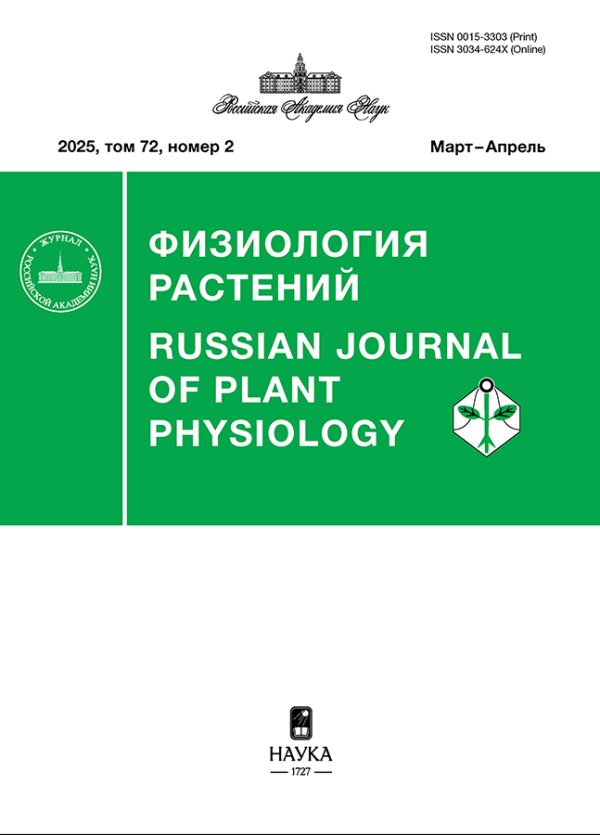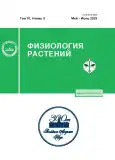Characteristics of a New Halotolerant Arctic Strain of Carotenogenic Microalga Halochlorella rubescens NAMSU SBB-20
- Authors: Zaitseva A.A.1, Bakhareva D.A.1, Zaitsev P.A.1, Lobakova E.S.1
-
Affiliations:
- Moscow State University
- Issue: Vol 70, No 3 (2023)
- Pages: 269-278
- Section: ЭКСПЕРИМЕНТАЛЬНЫЕ СТАТЬИ
- URL: https://journals.rcsi.science/0015-3303/article/view/130211
- DOI: https://doi.org/10.31857/S0015330322600735
- EDN: https://elibrary.ru/IBRXKH
- ID: 130211
Cite item
Full Text
Abstract
Green microalgae capable of accumulating secondary carotenoids are the most important objects of biotechnology, and the search for new strains with unique properties, in particular, those adapted to growth at low temperatures and high salinity in the environment, is an urgent task. The NAMSU SBB-20 microalga strain was isolated from an algal-bacterial biofilm found on the coast of the White Sea in the littoral zone of the Solovetsky Archipelago. Identification of the strain showed its belonging to the species Halochlorella rubescens P.J.L.Dangeard. The species H. rubescens was first described for the White Sea. Under conditions of high light intensity, ultrastructural changes in cells are shown, among which destruction of the photosynthetic apparatus and the formation of cytoplasmic and chloroplast lipid inclusions are noted. It was shown that the culture of the NAMSU SBB-20 strain is capable of acquiring an orange color under unfavorable growth conditions. An assessment was made of the effect of the composition of the medium and the intensity of illumination on the pigment composition of the algae. The highest absolute values of the accumulation of carotenoids were noted during cultivation in light with an intensity of 150 μmol PAR quanta/m2/s on BG-11 media containing no source of phosphorus (15.66 ± 0.18 mg/L) or nitrogen (15.95 ± 0.56 mg/L). The described strain has a biotechnological potential due to the initial halotolerance and the accumulation of high values of secondary carotenoids in the biomass.
About the authors
A. A. Zaitseva
Moscow State University
Author for correspondence.
Email: annakublanovskaya@gmail.com
Russian Federation, Moscow
D. A. Bakhareva
Moscow State University
Email: annakublanovskaya@gmail.com
Russian Federation, Moscow
P. A. Zaitsev
Moscow State University
Email: annakublanovskaya@gmail.com
Russian Federation, Moscow
E. S. Lobakova
Moscow State University
Email: annakublanovskaya@gmail.com
Russian Federation, Moscow
References
- Borowitzka M.A. Commercial production of microalgae: ponds, tanks, tubes and fermenters // J. Biotechnol. 1999. V. 70. № 1-3. P. 313. https://doi.org/10.1016/S0168-1656(99)00083-8
- Guerin M., Huntley M., Olaizola M. Haematococcus astaxanthin: applications for human health and nutrition // Trends Biotechnol. 2003. V. 21. № 5. P. 210. https://doi.org/10.1016/S0167-7799(03)00078-7
- Solovchenko A., Chekanov K. Production of carotenoids using microalgae cultivated in photobioreactors // Production of biomass and bioactive compounds using bioreactor technology / Eds. Paek K.Y., Murthy H., Zhong J. Dordrecht: Springer. 2014. P. 63. https://doi.org/10.1007/978-94-017-9223-3_4
- Chekanov K., Fedorenko T., Kublanovskaya A., Litvinov D., Lobakova E. Diversity of carotenogenic microalgae in the White Sea polar region // FEMS Microbiol. Ecol. 2020. V. 96. P. 183. https://doi.org/10.1093/femsec/fiz183/5632105
- Stanier R., Kunisawa R., Mandel M., Cohen-Bazire G. Purification and properties of unicellular blue-green algae (order Chroococcales) // Bacteriol. Rev. 1971. V. 35. P. 171. https://doi.org/10.1128/br.35.2.171-205.1971
- Темралеева А.Д., Минчева Е.В., Букин Ю.С., Андреева А.М. Современные методы выделения, культивирования и идентификации зеленых водорослей (Chlorophyta). Кострома: Костромской печатный дом, 2014. 215 с.
- Wang Y., Tian R.M., Gao Z.M., Bougouffa S., Qian P.Y. Optimal eukaryotic 18S and universal 16S/18S ribosomal RNA primers and their application in a study of symbiosis // PloS one. 2014. V. 9. № 3. e90053. https://doi.org/10.1371/journal.pone.0090053
- Ismagulova T., Chekanov K., Gorelova O., Baulina O., Semenova L., Selyakh, I., Chivkunova O., Lobakova E., Karpova O., Solovchenko A. A new subarctic strain of Tetradesmus obliquus – part I: identification and fatty acid profiling // J. Appl. Phycol. 2018. V. 30. № 5. P. 2737. https://doi.org/10.1007/s10811-017-1313-1
- Maltsev Y., Gusev E., Maltseva I., Kulikovskiy M., Namsaraev Z., Petrushkina M., Filimonova A., Sorokin B., Golubeva A., Butaeva G., Khrushchev A., Zotko N., Kuzmin D. Description of a new species of soil algae, Parietochloris grandis sp. nov., and study of its fatty acid profiles under different culturing conditions // Algal Res. 2018. V. 33. P. 358. https://doi.org/10.1016/j.algal.2018.06.008
- Altschul S.F., Madden T.L., Schäffer A.A., Zhang J., Zhang Z., Miller W., Lipman D.J. Gapped BLAST and PSI-BLAST: a new generation of protein database search programs // Nucleic Acids Res. 1997. V. 25. № 17. P. 3389. https://doi.org/10.1093/nar/25.17.3389
- Edgar G.J., Stuart-Smith R.D., Willis T.J., Kininmonth S., Baker S.C., Banks S., Thomson R.J. Global conservation outcomes depend on marine protected areas with five key features // Nature. 2014. V. 506. № 7487. P. 216.
- Kumar S., Stecher G., Tamura K. MEGA7: molecular evolutionary genetics analysis version 7.0 for bigger datasets // Mol. Biol. Evol. 2016. V. 33. № 7. P. 1870. https://doi.org/10.1093/molbev/msw054
- Aldrich J. RA Fisher and the making of maximum likelihood 1912-1922 // Stat Sci. 1997. V. 12. № 3. P. 162. https://doi.org/10.1214/ss/1030037906
- Kimura M. A simple method for estimating evolutionary rates of base substitutions through comparative studies of nucleotide sequences // J. Mol. Evol. 1980. V. 16. № 2. P. 111. https://doi.org/10.1007/BF01731581
- Nei M., Kumar S. Molecular evolution and phylogenetics. Oxford: Oxford University Press, 2000. 348 p.
- Felsenstein J. Confidence limits on phylogenies: an approach using the bootstrap // Evolution. 1985. V. 39. № 4. P. 783. https://doi.org/10.1111/j.1558-5646.1985.tb00420.x
- Gorelova O., Baulina O., Solovchenko A., Selyakh I., Chivkunova O., Semenova L., Scherbakov P., Burakova O., Lobakova E. Coordinated rearrangements of assimilatory and storage cell compartments in a nitrogen-starving symbiotic chlorophyte cultivated under high light // Arch. Microbiol. 2015. V. 197. P. 181. https://doi.org/10.1007/s00203-014-1036-5
- Reynolds E. The use of lead citrate at high pH as an electron-opaque stain in electron microscopy // J. Cell Biol. 1963. V. 17. № 1. P. 208. https://doi.org/10.1083/jcb.17.1.208
- Anderson T.F. Techniques for the preservaation of three-dimensional structure in preparing specimens for the electron microscope // Trans. N.Y. Acad. Sci. 1951. V. 13. № 4. P. 130. https://doi.org/10.1111/j.2164-0947.1951.tb01007.x
- Rippka R., Deruelles J., Waterbury J.B., Herdman M., Stanier R.Y. Generic assignments, strain histories and properties of pure cultures of cyanobacteria // Microbiology. 1979. V. 111. № 1. P. 1. https://doi.org/10.1099/00221287-111-1-1
- Solovchenko A., Merzlyak M.N., Khozin-Goldberg I., Cohen Z., Boussiba S. Coordinated carotenoid and lipid syntheses induced in parietochloris incisa (Chlorophyta, trebouxiophyceae) mutant deficient in δ5 desaturase by nitrogen starvation and high light // J. Phycol. 2010. V. 46. № 4. P. 763. https://doi.org/10.1111/j.1529-8817.2010.00849.x
- Guiry M.D., Guiry G.M. AlgaeBase. World-wide electronic publication. National University of Ireland, Galway; https://www.algaebase.org; searched on 26 November 2022
- Kessler E., Schäfer M., Hümmer C., Kloboucek A., Huss V.A.R. Physiological, biochemical, and molecular characters for taxonomy of the subgenera of Scenedesmus (Chlorococcales, Chlorophyta) // Bot. Acta. 1997. V. 110. P. 244. https://doi.org/10.1111/j.1438-8677.1997.tb00636.x
- Kessler E., Czygan F.C., Fott B., Nováková M. Über Halochlorella rubescens Dangeard // Protistenk. 1968. V. 110 P. 462.
- Kalina T., Puncochárová M. Taxonomy of the subfamily Scotiellocystoideae Fott 1976 (Chlorellaceae, Chlorophyceae) // Archiv für Hydrobiologie. Supplementband. Monographische Beiträge. 1987. V. 73. № 4. P. 473.
- Huss V.A., Frank C., Hartmann E.C., Hirmer M., Kloboucek A., Seidel B.M., Wenzeler P., Kessler E. Biochemical taxonomy and molecular phylogeny of the genus Chlorella sensu lato (Chlorophyta) // J. Phycol. 1999. V. 35. № 3. P. 587.https://doi.org/10.1046/j.1529-8817.1999.3530587.x
- Чесунов А.В., Калякина Н.М., Бубнова Е.Н. Каталог биоты Беломорской биологической станции МГУ. Москва: Товарищество научных изданий КМК. 2008. 384 с.
- Shi J., Podola B., Melkonian M. Application of a prototype-scale Twin-Layer photobioreactor for effective N and P removal from different process stages of municipal wastewater by immobilized microalgae // Biores. Technol. 2014. V. 154. P. 260. https://doi.org/10.1016/j.biortech.2013.11.100
- Jo S.W., Hong J.W., Do J.M., Na H., Kim J.J., Park S.I., Kim Y.S., Kim I.S., Yoon H.S. Nitrogen deficiency-dependent abiotic stress enhances carotenoid production in indigenous green microalga Scenedesmus rubescens KNUA042, for use as a potential resource of high value products // Sustainability. 2020. V. 12. № 13. P. 5445. https://doi.org/10.3390/su12135445
- Tsavatopoulou V.D., Aravantinou A.F., Vakros J., Manariotis I.D. Conversion of Scenedesmus rubescens lipid into biodiesel by biochar of different origin // Catalysts. 2021. V. 11. № 9. P. 1116. https://doi.org/10.3390/catal11091116
- Zaytseva A., Chekanov K., Zaytsev P., Bakhareva D., Gorelova O., Kochkin D., Lobakova E. Sunscreen effect exerted by secondary carotenoids and mycosporine-like amino acids in the aeroterrestrial chlorophyte Coelastrella rubescens under high light and UV-A irradiation // Plants. 2021. V. 10. № 12. P. 2601. https://doi.org/10.3390/plants10122601
- Solovchenko A.E. Physiological role of neutral lipid accumulation in eukaryotic microalgae under stresses // Russ. J. Plant Physiol. 2012. V. 59. № 2. P. 167. https://doi.org/10.1134/S1021443712020161
- Davidi L., Shimoni E., Khozin-Goldberg I., Zamir A., Pick U. Origin of β-carotene-rich plastoglobuli in Dunaliella bardawil // Plant Physiol. 2014. V. 164. № 4. P. 2139. https://doi.org/10.1104/pp.113.235119
- Ota S., Morita A., Ohnuki S., Hirata A., Sekida S., Okuda K., Ohya Y., Kawano S. Carotenoid dynamics and lipid droplet containing astaxanthin in response to light in the green alga Haematococcus pluvialis // Sci. Rep. 2018. V. 8. № 1. P. 1. https://doi.org/10.1038/s41598-018-23854-w
- Chekanov K., Litvinov D., Fedorenko T., Chivkunova O., Lobakova E. Combined production of astaxanthin and β-carotene in a new strain of the microalga Bracteacoccus aggregatus BM5/15 (IPPAS C-2045) cultivated in photobioreactor // Biology. 2021. V. 10. № 7. P. 643. https://doi.org/10.3390/biology10070643
Supplementary files















